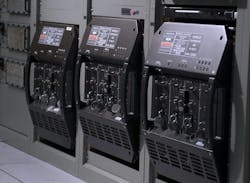Navy asks General Dynamics to build shipboard software-defined radio systems with NSA Type 1 encryption
SAN DIEGO – U.S. Navy shipboard communications experts are asking General Dynamics Corp. to provide AN/USC-61(C) maritime radios to enable Navy surface warships and submarines to communicate over high frequency (HF), ultra-high frequency (UHF) line of sight, UHF satellite communications (SATCOM), and very high frequency (VHF) radio bands.
Officials of the Naval Information Warfare Systems Command (NAVWAR) in San Diego announced a $49.9 million order Monday to the General Dynamics Mission Systems segment in Scottsdale, Ariz., to build AN/USC-61(C) digital modular radio (DMR) systems.
The contract includes high-frequency distribution amplifier group components and engineering services for continued fielding and maintenance of the maritime radio communications system.
DMR is a modular, software reprogrammable shipboard radio system with embedded cryptography that provides all radio frequency (RF) to-baseband and baseband-to-RF conversion functions required for U.S. naval line-of-sight, beyond line-of-sight and satellite communications systems.
Related: Marine Corps picks secure HF radio systems from L3Harris
This contract modification asks General Dynamics engineers to carry out new radio communications requirements that were not anticipated in the original contract award. NAVWAR awarded the order on behalf of the Navy’s Program Executive Office for Command, Control, Communication, Computers, and Intelligence (PEO C4I) in San Diego.
The AN/USC-61(C) is a maritime software-defined radio (SDR) that has become standard for the U.S. military. The compact, multi-channel DMR provides several different waveforms and multi-level information security for voice and data communications.
The radio includes NSA Type 1 encryption; embedded red/black baseband switching and routing; co-site performance; reduced manpower requirements; single point of control for HF/VHF/UHF/SATCOM radio communications; and built-in test (BIT).
Software-defined radio waveforms are computer programs that enable SDR-enable radios to operate on different frequency bands with different encryption and cyber security functions. The AN/USC-61(C) operates on Navy surface ships, submarines, and other military platforms using frequencies from 2 MHz to 2 GHz.
General Dynamics has certified the DMR to pass secure voice and data at multiple independent levels of security (MILS) over HF, VHF, UHF, and SATCOM channels, and to withstand the effects of electromagnetic interference and other harsh operating conditions.
The DMR also is certified by the Joint Interoperability Test Command (JITC) to be compliant with the U.S. government’s MIL-STD-188-181B/182A/183A requirements for UHF SATCOM. General Dynamics builds the AN/USC-61(C) using open-architecture standards.
On this order, General Dynamics will do the work in Scottsdale, Ariz., and should be finished by December 2022. For more information contact General Dynamics Mission Systems online at https://gdmissionsystems.com, or NAVWAR at www.navwar.navy.mil.
About the Author
John Keller
Editor-in-Chief
John Keller is the Editor-in-Chief, Military & Aerospace Electronics Magazine--provides extensive coverage and analysis of enabling electronics and optoelectronic technologies in military, space and commercial aviation applications. John has been a member of the Military & Aerospace Electronics staff since 1989 and chief editor since 1995.
